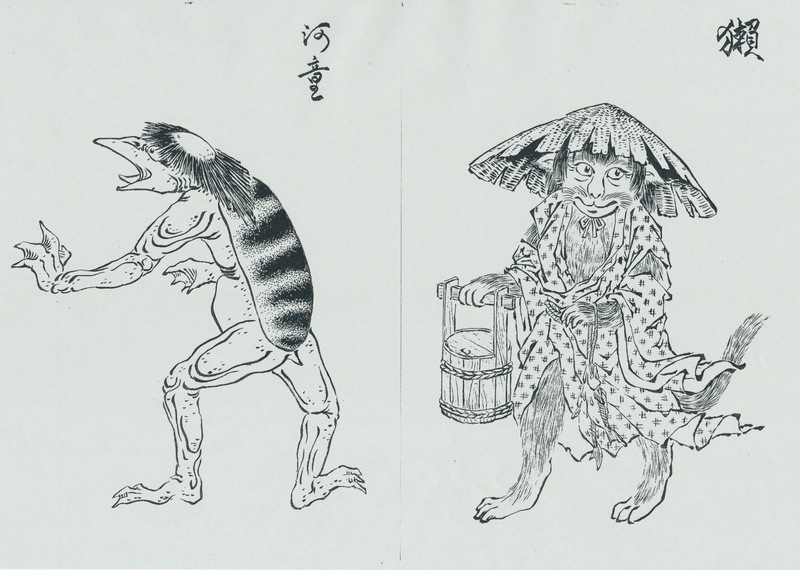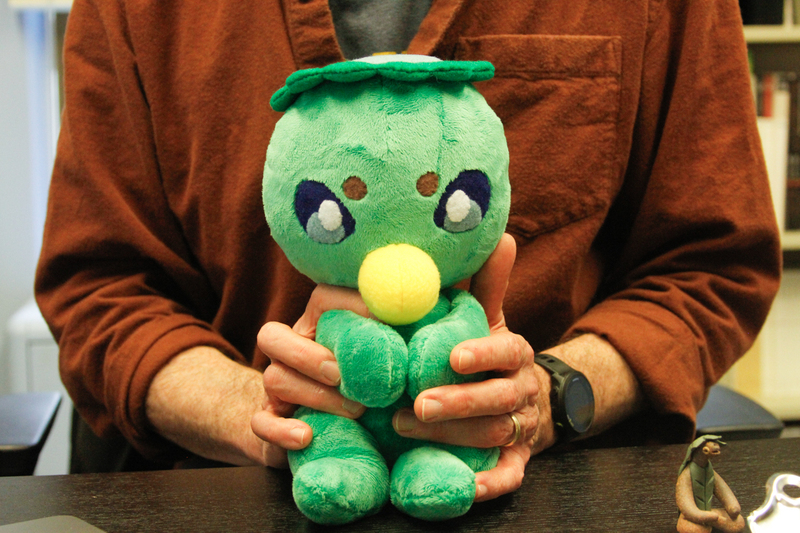This article was originally published on the UC Davis Letters & Sciences website and can be read here
UC Davis Folklore Professor Hosts Series in Japan
- by Maria Sestito
- October 31, 2024
Perched on a tall bookshelf between mythology and folklore texts in Michael Dylan Foster’s office sits a green statuette, its mouth agape and hiding its eyes behind webbed fingers. It wears a shell on its back and what looks like a lily pad on its head. At first glance, it could be mistaken for a turtle or a frog.

Illustrations of a kappa and a kawauso, types of yokai or Japanese mythical creatures, by Kijin Shinonome. (Courtesy of Michael Dylan Foster)
It is called a “kappa,” and despite the figurine’s charm, the water sprite is known for pulling children into rivers and drowning them. It is also known for having top-notch bone-setting skills.
This peculiar creature was the first “yōkai” to incite Foster’s curiosity. A professor in the Department of East Asian Languages and Cultures at UC Davis, Foster had brought a similar statue home as a souvenir after teaching English in Japan in the early 1990s.
“I’d never really thought about it and one day I started looking at it and I thought, ‘What is this thing?’” Foster recalled. He’s been researching yōkai, Japanese monsters and ghosts, ever since.
Foster is an author, anthology editor and the host of a mini-series about “yōkai” for The Japan Broadcasting Corporation (NHK). He recently finished filming the latest season of the series this past summer. All three episodes are available on-demand through NHK World.
‘Yōkai’ grows in popularity
Yōkai is a catch-all term for all the monsters, mythical creatures, ghosts and goblins living within Japanese culture. Their influence can be seen throughout Japanese art, texts, games and popular culture.

Professor Michael Dylan Foster holds a stuffed kappa made by a student. (Photo by Maria Sestito, UC Davis)
Foster is interested in the “soft power of Japanese culture” and the ways in which popular culture, literature and film draw on, allude to and even co-opt Japanese folklore. About a decade ago, he coined the term “folkloresque” to refer to the ways media uses the authority and cultural flavor of folklore to “endow the pop culture products with a sense of authenticity, or a sense of being tied to something traditional or older than the thing itself.”
In his first book, Pandemonium and Parade: Japanese Monsters and the Culture of Yokai (UC Press, 2009), Foster sheds light on how yōkai evolved from beliefs to products over the course of three centuries.
At that time, his publishers worried no one would know what the word “yōkai” meant and dissuaded him from making it the main part of the title. Just six years later, however, as manga and anime became increasingly more popular around the world, his publishers wanted to embrace the word, resulting in The Book of Yōkai (UC Press, 2015).
Interest in the field has grown so much that Foster and illustrator Shinonome Kijin released a second expanded edition of The Book of Yōkai this year. In it, Foster explains how the creatures have had different meanings and usages throughout the years, and invites audiences to examine their impact on the creation, dissemination and evolution of these legends.
Yōkai mysteries now streaming
Foster has been hosting the mini-series, YŌKAI: Exploring Hidden Japanese Folklore, which focuses on more rural yōkai, since 2022. In the last two years, he’s woken up before dawn to ride-along with and interview sailors and fisherman, been invited into peoples’ homes for family dinners and traveled to rural villages and temples, learning stories passed on from generation to generation.
In one episode, Foster explores the legend of hitotsume-kozo, one-eyed monsters who punish those who’ve done bad deeds. There are some adults who, scared as children by such threatening tales, keep up traditions meant to keep hitotsume-kozo away.

On location for the NHK show about Japanese mythical creatures hosted by Michael Dylan Foster. (Photo courtesy of Michael Dylan Foster)
Just like the legends and forms of the kappa can vary from place to place, so too do the stories around the other yōkai. Like hitotsumekozo, who are often seen as horrifying or humorous, many yōkai can be both feared and made fun of at the same time. And, though sometimes potential explanations of their existence may come easy, other stories don’t satisfy logical thinking.
For example, Foster said, the kappa legends “could be interpreted simply as ‘be careful around water.’ There's that kind of practical aspect of the legend, if you want to look for a function."
But then, why are kappa also known for their medical knowledge? And why bone-setting, in particular?
The stories are complicated and open to interpretation.
“For me, I think what fascinates me about yōkai is that aspect of it — the way it means so many different things to different people at different times and even simultaneously,” Foster said. “At the core of it is the question of ‘what is real?’”
